Florida East Coast Railway
The Florida East Coast Railway (reporting mark FEC) is a Class II railroad operating in the U.S. state of Florida, currently owned by Grupo México.
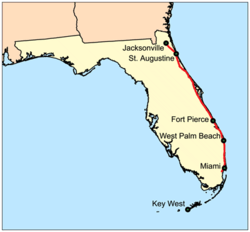 FEC route map | |||||||||||||||||||||||||||||||||||||||||||||||||||||||||||||||||||||||||||||||||||||||||||||||||||||||||||||||||||||||||||||||||||||||||||||||||||||||||||||||||||||||||||||||||||||||||||||||||||||||||||||||||||||||||||||||||||||||||||||||||||||||||||||||||||||||||||||||||||||||||||||||||||||||||||||||||||||||||||||||||||||||||||||||||||||||||||||||||||||||||||||||||||||||||||||||||||||||||||||||||||||||||||||||||||||||||||||||||||||||||||||||||||||||||||||||||||||||||||||||||||||||||||||||||||||||||||||||||||||||||||||||||||||||||||||||||||||||||||||||||||||||||||||||||||||||||||||||||||||||||||||||||||||||||||||||||||||||||||||||||||||||||||||||||||||||||||||||||||||||||||||||||||||||||||||||||||||||||||||||||||||||||||||||||||||||||||||||||||||||||||||||||||||||||||||||||||||||||||||||||||||||||||||||||||||||||||||||||||||||||||||||||||||||||||||||||||||||||||||||||||||||||||||||||||||||||||||||||||||||||||||||||||||||||||||||||||||||||||||||||||||||||||||||||||||||||||||||||||||||
| Overview | |||||||||||||||||||||||||||||||||||||||||||||||||||||||||||||||||||||||||||||||||||||||||||||||||||||||||||||||||||||||||||||||||||||||||||||||||||||||||||||||||||||||||||||||||||||||||||||||||||||||||||||||||||||||||||||||||||||||||||||||||||||||||||||||||||||||||||||||||||||||||||||||||||||||||||||||||||||||||||||||||||||||||||||||||||||||||||||||||||||||||||||||||||||||||||||||||||||||||||||||||||||||||||||||||||||||||||||||||||||||||||||||||||||||||||||||||||||||||||||||||||||||||||||||||||||||||||||||||||||||||||||||||||||||||||||||||||||||||||||||||||||||||||||||||||||||||||||||||||||||||||||||||||||||||||||||||||||||||||||||||||||||||||||||||||||||||||||||||||||||||||||||||||||||||||||||||||||||||||||||||||||||||||||||||||||||||||||||||||||||||||||||||||||||||||||||||||||||||||||||||||||||||||||||||||||||||||||||||||||||||||||||||||||||||||||||||||||||||||||||||||||||||||||||||||||||||||||||||||||||||||||||||||||||||||||||||||||||||||||||||||||||||||||||||||||||||||||||||||||||
|---|---|---|---|---|---|---|---|---|---|---|---|---|---|---|---|---|---|---|---|---|---|---|---|---|---|---|---|---|---|---|---|---|---|---|---|---|---|---|---|---|---|---|---|---|---|---|---|---|---|---|---|---|---|---|---|---|---|---|---|---|---|---|---|---|---|---|---|---|---|---|---|---|---|---|---|---|---|---|---|---|---|---|---|---|---|---|---|---|---|---|---|---|---|---|---|---|---|---|---|---|---|---|---|---|---|---|---|---|---|---|---|---|---|---|---|---|---|---|---|---|---|---|---|---|---|---|---|---|---|---|---|---|---|---|---|---|---|---|---|---|---|---|---|---|---|---|---|---|---|---|---|---|---|---|---|---|---|---|---|---|---|---|---|---|---|---|---|---|---|---|---|---|---|---|---|---|---|---|---|---|---|---|---|---|---|---|---|---|---|---|---|---|---|---|---|---|---|---|---|---|---|---|---|---|---|---|---|---|---|---|---|---|---|---|---|---|---|---|---|---|---|---|---|---|---|---|---|---|---|---|---|---|---|---|---|---|---|---|---|---|---|---|---|---|---|---|---|---|---|---|---|---|---|---|---|---|---|---|---|---|---|---|---|---|---|---|---|---|---|---|---|---|---|---|---|---|---|---|---|---|---|---|---|---|---|---|---|---|---|---|---|---|---|---|---|---|---|---|---|---|---|---|---|---|---|---|---|---|---|---|---|---|---|---|---|---|---|---|---|---|---|---|---|---|---|---|---|---|---|---|---|---|---|---|---|---|---|---|---|---|---|---|---|---|---|---|---|---|---|---|---|---|---|---|---|---|---|---|---|---|---|---|---|---|---|---|---|---|---|---|---|---|---|---|---|---|---|---|---|---|---|---|---|---|---|---|---|---|---|---|---|---|---|---|---|---|---|---|---|---|---|---|---|---|---|---|---|---|---|---|---|---|---|---|---|---|---|---|---|---|---|---|---|---|---|---|---|---|---|---|---|---|---|---|---|---|---|---|---|---|---|---|---|---|---|---|---|---|---|---|---|---|---|---|---|---|---|---|---|---|---|---|---|---|---|---|---|---|---|---|---|---|---|---|---|---|---|---|---|---|---|---|---|---|---|---|---|---|---|---|---|---|---|---|---|---|---|---|---|---|---|---|---|---|---|---|---|---|---|---|---|---|---|---|---|---|---|---|---|---|---|---|---|---|---|---|---|---|---|---|---|---|---|---|---|---|---|---|---|---|---|---|---|---|---|---|---|---|---|---|---|---|---|---|---|---|---|---|---|---|---|---|---|---|---|---|---|---|---|---|---|---|---|---|---|---|---|---|---|---|---|---|---|---|---|---|---|---|---|---|---|---|---|---|---|---|---|---|---|---|---|---|---|---|---|---|---|---|---|---|---|---|---|---|---|---|---|---|---|---|---|---|---|---|---|---|---|---|---|---|---|---|---|---|---|---|---|---|---|---|---|---|---|---|---|---|---|---|---|---|---|---|---|---|---|---|---|---|---|---|---|---|---|---|---|---|---|---|---|---|---|---|---|---|---|---|---|---|---|---|---|---|---|---|---|---|---|---|---|---|---|---|---|---|---|---|---|---|---|---|---|---|---|---|---|---|---|---|---|---|---|---|---|---|---|---|---|---|---|---|---|---|---|---|---|---|---|---|---|---|---|---|---|---|---|---|---|---|---|---|---|---|---|---|---|---|---|---|---|---|---|---|---|---|---|---|---|---|---|---|---|---|---|---|---|---|---|---|---|---|---|---|---|---|---|---|---|---|---|---|---|---|---|---|---|---|---|---|---|---|---|---|---|---|---|---|---|---|---|---|---|---|---|---|---|---|---|---|---|---|---|---|---|---|---|---|---|---|---|---|---|---|---|---|---|---|---|---|---|---|---|---|---|---|---|---|---|---|---|---|---|---|---|---|---|---|---|---|---|---|---|---|---|---|---|---|---|---|---|---|---|---|---|---|---|---|---|---|---|---|---|---|---|---|---|---|---|---|---|---|---|---|---|---|---|---|---|---|---|---|---|---|---|---|---|---|---|---|---|---|---|---|---|---|---|---|---|---|---|---|---|---|---|---|---|---|---|---|---|---|---|---|---|---|---|---|---|---|---|---|---|---|---|---|---|---|---|---|---|---|---|---|---|---|---|---|---|---|---|---|---|---|---|---|---|---|---|---|---|---|---|---|---|---|---|---|---|---|---|---|---|---|---|---|---|---|---|---|---|---|---|---|---|---|---|---|---|---|---|---|---|---|---|---|---|---|---|---|---|
| Headquarters | Jacksonville, Florida | ||||||||||||||||||||||||||||||||||||||||||||||||||||||||||||||||||||||||||||||||||||||||||||||||||||||||||||||||||||||||||||||||||||||||||||||||||||||||||||||||||||||||||||||||||||||||||||||||||||||||||||||||||||||||||||||||||||||||||||||||||||||||||||||||||||||||||||||||||||||||||||||||||||||||||||||||||||||||||||||||||||||||||||||||||||||||||||||||||||||||||||||||||||||||||||||||||||||||||||||||||||||||||||||||||||||||||||||||||||||||||||||||||||||||||||||||||||||||||||||||||||||||||||||||||||||||||||||||||||||||||||||||||||||||||||||||||||||||||||||||||||||||||||||||||||||||||||||||||||||||||||||||||||||||||||||||||||||||||||||||||||||||||||||||||||||||||||||||||||||||||||||||||||||||||||||||||||||||||||||||||||||||||||||||||||||||||||||||||||||||||||||||||||||||||||||||||||||||||||||||||||||||||||||||||||||||||||||||||||||||||||||||||||||||||||||||||||||||||||||||||||||||||||||||||||||||||||||||||||||||||||||||||||||||||||||||||||||||||||||||||||||||||||||||||||||||||||||||||||||
| Reporting mark | FEC | ||||||||||||||||||||||||||||||||||||||||||||||||||||||||||||||||||||||||||||||||||||||||||||||||||||||||||||||||||||||||||||||||||||||||||||||||||||||||||||||||||||||||||||||||||||||||||||||||||||||||||||||||||||||||||||||||||||||||||||||||||||||||||||||||||||||||||||||||||||||||||||||||||||||||||||||||||||||||||||||||||||||||||||||||||||||||||||||||||||||||||||||||||||||||||||||||||||||||||||||||||||||||||||||||||||||||||||||||||||||||||||||||||||||||||||||||||||||||||||||||||||||||||||||||||||||||||||||||||||||||||||||||||||||||||||||||||||||||||||||||||||||||||||||||||||||||||||||||||||||||||||||||||||||||||||||||||||||||||||||||||||||||||||||||||||||||||||||||||||||||||||||||||||||||||||||||||||||||||||||||||||||||||||||||||||||||||||||||||||||||||||||||||||||||||||||||||||||||||||||||||||||||||||||||||||||||||||||||||||||||||||||||||||||||||||||||||||||||||||||||||||||||||||||||||||||||||||||||||||||||||||||||||||||||||||||||||||||||||||||||||||||||||||||||||||||||||||||||||||||
| Locale | Florida | ||||||||||||||||||||||||||||||||||||||||||||||||||||||||||||||||||||||||||||||||||||||||||||||||||||||||||||||||||||||||||||||||||||||||||||||||||||||||||||||||||||||||||||||||||||||||||||||||||||||||||||||||||||||||||||||||||||||||||||||||||||||||||||||||||||||||||||||||||||||||||||||||||||||||||||||||||||||||||||||||||||||||||||||||||||||||||||||||||||||||||||||||||||||||||||||||||||||||||||||||||||||||||||||||||||||||||||||||||||||||||||||||||||||||||||||||||||||||||||||||||||||||||||||||||||||||||||||||||||||||||||||||||||||||||||||||||||||||||||||||||||||||||||||||||||||||||||||||||||||||||||||||||||||||||||||||||||||||||||||||||||||||||||||||||||||||||||||||||||||||||||||||||||||||||||||||||||||||||||||||||||||||||||||||||||||||||||||||||||||||||||||||||||||||||||||||||||||||||||||||||||||||||||||||||||||||||||||||||||||||||||||||||||||||||||||||||||||||||||||||||||||||||||||||||||||||||||||||||||||||||||||||||||||||||||||||||||||||||||||||||||||||||||||||||||||||||||||||||||||
| Dates of operation | 1885–present | ||||||||||||||||||||||||||||||||||||||||||||||||||||||||||||||||||||||||||||||||||||||||||||||||||||||||||||||||||||||||||||||||||||||||||||||||||||||||||||||||||||||||||||||||||||||||||||||||||||||||||||||||||||||||||||||||||||||||||||||||||||||||||||||||||||||||||||||||||||||||||||||||||||||||||||||||||||||||||||||||||||||||||||||||||||||||||||||||||||||||||||||||||||||||||||||||||||||||||||||||||||||||||||||||||||||||||||||||||||||||||||||||||||||||||||||||||||||||||||||||||||||||||||||||||||||||||||||||||||||||||||||||||||||||||||||||||||||||||||||||||||||||||||||||||||||||||||||||||||||||||||||||||||||||||||||||||||||||||||||||||||||||||||||||||||||||||||||||||||||||||||||||||||||||||||||||||||||||||||||||||||||||||||||||||||||||||||||||||||||||||||||||||||||||||||||||||||||||||||||||||||||||||||||||||||||||||||||||||||||||||||||||||||||||||||||||||||||||||||||||||||||||||||||||||||||||||||||||||||||||||||||||||||||||||||||||||||||||||||||||||||||||||||||||||||||||||||||||||||||
| Technical | |||||||||||||||||||||||||||||||||||||||||||||||||||||||||||||||||||||||||||||||||||||||||||||||||||||||||||||||||||||||||||||||||||||||||||||||||||||||||||||||||||||||||||||||||||||||||||||||||||||||||||||||||||||||||||||||||||||||||||||||||||||||||||||||||||||||||||||||||||||||||||||||||||||||||||||||||||||||||||||||||||||||||||||||||||||||||||||||||||||||||||||||||||||||||||||||||||||||||||||||||||||||||||||||||||||||||||||||||||||||||||||||||||||||||||||||||||||||||||||||||||||||||||||||||||||||||||||||||||||||||||||||||||||||||||||||||||||||||||||||||||||||||||||||||||||||||||||||||||||||||||||||||||||||||||||||||||||||||||||||||||||||||||||||||||||||||||||||||||||||||||||||||||||||||||||||||||||||||||||||||||||||||||||||||||||||||||||||||||||||||||||||||||||||||||||||||||||||||||||||||||||||||||||||||||||||||||||||||||||||||||||||||||||||||||||||||||||||||||||||||||||||||||||||||||||||||||||||||||||||||||||||||||||||||||||||||||||||||||||||||||||||||||||||||||||||||||||||||||||||
| Track gauge | 4 ft 8 1⁄2 in (1,435 mm) standard gauge | ||||||||||||||||||||||||||||||||||||||||||||||||||||||||||||||||||||||||||||||||||||||||||||||||||||||||||||||||||||||||||||||||||||||||||||||||||||||||||||||||||||||||||||||||||||||||||||||||||||||||||||||||||||||||||||||||||||||||||||||||||||||||||||||||||||||||||||||||||||||||||||||||||||||||||||||||||||||||||||||||||||||||||||||||||||||||||||||||||||||||||||||||||||||||||||||||||||||||||||||||||||||||||||||||||||||||||||||||||||||||||||||||||||||||||||||||||||||||||||||||||||||||||||||||||||||||||||||||||||||||||||||||||||||||||||||||||||||||||||||||||||||||||||||||||||||||||||||||||||||||||||||||||||||||||||||||||||||||||||||||||||||||||||||||||||||||||||||||||||||||||||||||||||||||||||||||||||||||||||||||||||||||||||||||||||||||||||||||||||||||||||||||||||||||||||||||||||||||||||||||||||||||||||||||||||||||||||||||||||||||||||||||||||||||||||||||||||||||||||||||||||||||||||||||||||||||||||||||||||||||||||||||||||||||||||||||||||||||||||||||||||||||||||||||||||||||||||||||||||||
| Other | |||||||||||||||||||||||||||||||||||||||||||||||||||||||||||||||||||||||||||||||||||||||||||||||||||||||||||||||||||||||||||||||||||||||||||||||||||||||||||||||||||||||||||||||||||||||||||||||||||||||||||||||||||||||||||||||||||||||||||||||||||||||||||||||||||||||||||||||||||||||||||||||||||||||||||||||||||||||||||||||||||||||||||||||||||||||||||||||||||||||||||||||||||||||||||||||||||||||||||||||||||||||||||||||||||||||||||||||||||||||||||||||||||||||||||||||||||||||||||||||||||||||||||||||||||||||||||||||||||||||||||||||||||||||||||||||||||||||||||||||||||||||||||||||||||||||||||||||||||||||||||||||||||||||||||||||||||||||||||||||||||||||||||||||||||||||||||||||||||||||||||||||||||||||||||||||||||||||||||||||||||||||||||||||||||||||||||||||||||||||||||||||||||||||||||||||||||||||||||||||||||||||||||||||||||||||||||||||||||||||||||||||||||||||||||||||||||||||||||||||||||||||||||||||||||||||||||||||||||||||||||||||||||||||||||||||||||||||||||||||||||||||||||||||||||||||||||||||||||||||
| Website | www | ||||||||||||||||||||||||||||||||||||||||||||||||||||||||||||||||||||||||||||||||||||||||||||||||||||||||||||||||||||||||||||||||||||||||||||||||||||||||||||||||||||||||||||||||||||||||||||||||||||||||||||||||||||||||||||||||||||||||||||||||||||||||||||||||||||||||||||||||||||||||||||||||||||||||||||||||||||||||||||||||||||||||||||||||||||||||||||||||||||||||||||||||||||||||||||||||||||||||||||||||||||||||||||||||||||||||||||||||||||||||||||||||||||||||||||||||||||||||||||||||||||||||||||||||||||||||||||||||||||||||||||||||||||||||||||||||||||||||||||||||||||||||||||||||||||||||||||||||||||||||||||||||||||||||||||||||||||||||||||||||||||||||||||||||||||||||||||||||||||||||||||||||||||||||||||||||||||||||||||||||||||||||||||||||||||||||||||||||||||||||||||||||||||||||||||||||||||||||||||||||||||||||||||||||||||||||||||||||||||||||||||||||||||||||||||||||||||||||||||||||||||||||||||||||||||||||||||||||||||||||||||||||||||||||||||||||||||||||||||||||||||||||||||||||||||||||||||||||||||||
| |||||||||||||||||||||||||||||||||||||||||||||||||||||||||||||||||||||||||||||||||||||||||||||||||||||||||||||||||||||||||||||||||||||||||||||||||||||||||||||||||||||||||||||||||||||||||||||||||||||||||||||||||||||||||||||||||||||||||||||||||||||||||||||||||||||||||||||||||||||||||||||||||||||||||||||||||||||||||||||||||||||||||||||||||||||||||||||||||||||||||||||||||||||||||||||||||||||||||||||||||||||||||||||||||||||||||||||||||||||||||||||||||||||||||||||||||||||||||||||||||||||||||||||||||||||||||||||||||||||||||||||||||||||||||||||||||||||||||||||||||||||||||||||||||||||||||||||||||||||||||||||||||||||||||||||||||||||||||||||||||||||||||||||||||||||||||||||||||||||||||||||||||||||||||||||||||||||||||||||||||||||||||||||||||||||||||||||||||||||||||||||||||||||||||||||||||||||||||||||||||||||||||||||||||||||||||||||||||||||||||||||||||||||||||||||||||||||||||||||||||||||||||||||||||||||||||||||||||||||||||||||||||||||||||||||||||||||||||||||||||||||||||||||||||||||||||||||||||||||||
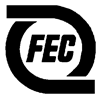
The FEC was historically a Class I railroad owned by Florida East Coast Industries (FECI) from 2000 to 2016, FOXX Holdings between 1983 and 2000, and the St. Joseph Paper Company prior to 1983.
Built primarily in the last quarter of the 19th century and the first decade of the 20th century, the FEC was a project of Standard Oil principal Henry Flagler. He originally visited Florida with his first wife, Mary; they sought assistance with the health issues she faced. A key strategist who worked closely with John D. Rockefeller building the Standard Oil Trust, Flagler noted both great potential and a lack of services during his stay at St. Augustine. He subsequently began what amounted to his second career, developing resorts, industries, and communities all along Florida's shores abutting the Atlantic Ocean.
The FEC is possibly best known for building the railroad to Key West, completed in 1912. When the FEC's line from the mainland to Key West was heavily damaged by the Labor Day Hurricane of 1935, the State of Florida purchased the remaining right-of-way and bridges south of Dade County, and they were rebuilt into road bridges for vehicle traffic and became known as the Overseas Highway. However, a greater and lasting Flagler legacy was the developments along Florida's eastern coast.
During the Great Depression, control was purchased by heirs of the du Pont family. After 30 years of fragile financial condition, the FEC, under leadership of a new president, Ed Ball, took on the labor unions. Ball claimed the company could not afford the same costs as larger Class 1 railroads and needed to invest saved funds in its infrastructure, the condition of which was fast becoming a safety issue. The company—using replacement workers—and some of its employees engaged from 1963 until 1977 in one of the longest and more violent labor conflicts of the 20th century. Ultimately, federal authorities had to intervene to stop the violence, which included bombings, shootings and vandalism.[1] However, the courts ruled in the FEC's favor with regard to the right to employ strikebreakers. During this time Ball invested heavily in numerous steps to improve the railroad's physical plant, and installed various forms of automation. The FEC was the first US railroad to operate two-man train crews, eliminate cabooses, and end all of its passenger services (which were unprofitable) by 1968.
Today the company's primary rail revenues come from its intermodal and rock trains. In January 2018, passenger rail service Brightline began using FEC tracks for its route from West Palm Beach to Miami with a stop at Fort Lauderdale.
Henry Flagler: developing Florida's east coast

The Florida East Coast Railway (FEC) was developed by Henry Morrison Flagler, an American tycoon, real estate promoter, railroad developer and John D. Rockefeller's partner in Standard Oil. Formed at Cleveland, Ohio as Rockefeller, Andrews & Flagler in 1867, Standard Oil moved its headquarters in 1877 to New York City. Flagler and his family relocated there as well. He was joined by Henry H. Rogers, another leader of Standard Oil who also became involved in the development of America's railroads, including those on nearby Staten Island, the Union Pacific, and later in West Virginia, where he eventually built the remarkable Virginian Railway to transport coal to Hampton Roads, Virginia.
Flagler's non-Standard Oil interests went in a different direction, however, when in 1878, on the advice of his physician, he traveled to Jacksonville, Florida for the winter with his first wife, Mary, who was quite ill. Two years after she died in 1881, he married Mary's former caregiver, Ida Alice Shourds. After their wedding, the couple traveled to St. Augustine, Florida in 1883. Flagler found the city charming, but the hotel facilities and transportation systems inadequate. He recognized Florida's potential to attract out-of-state visitors. Though Flagler remained on the Board of Directors of Standard Oil, he gave up his day-to-day involvement in the firm in order to pursue his Florida interests.
When Flagler returned to Florida, in 1885 he began building a grand St. Augustine hotel, the Ponce de Leon Hotel. Flagler realized that the key to developing Florida was a solid transportation system, and consequently purchased the 3 ft (914 mm) narrow gauge Jacksonville, St. Augustine and Halifax River Railway (JStA&HR) on December 31, 1885. He also discovered that a major problem facing the existing Florida railway systems was that each operated on different gauge systems, making interconnection impossible. He converted the line to 4 ft 8 1⁄2 in (1,435 mm) standard gauge in 1890 and the small operation was incorporated in 1892.
The earliest predecessor of the FEC was the narrow gauge St. John's Railway, incorporated in 1858, which constructed a now-abandoned line between St. Augustine and Tocoi, a small settlement on the east bank of the St. Johns River, midway between Palatka and Green Cove Springs. In 1883, Henry Flagler, now retired from Standard Oil, moved to St. Augustine, built the previously mentioned Ponce de Leon and the Alcazar Hotels, and purchased the Casa Monica, just east of the Alcazar, changing the name to Cordova. The east coast of Florida was relatively undeveloped at that time, and Flagler found it difficult to obtain the construction materials he needed. His purchase of the JStA&HR Railway was intended to make it faster and easier to supply his building projects.
The JStA&HR Railway served the northeastern portion of the state and was the first operation in the Flagler Railroad system. Before Flagler bought the line, the railroad stretched only between South Jacksonville and St. Augustine and lacked a depot sufficient to accommodate travelers to his St. Augustine resorts. He built a modern depot facility as well as schools, hospitals and churches, systematically revitalizing the largely abandoned historic city.
Flagler next purchased three additional existing railroads: the St. John's Railway, the St. Augustine and Palatka Railway, and the St. Johns and Halifax River Railway so that he could provide extended rail service on standard gauge tracks. Through the operation of these three railroads, by spring 1889 Flagler's system offered service from Jacksonville to Daytona. Continuing to develop hotel facilities to entice northern tourists to visit Florida, Flagler bought and expanded the Ormond Hotel, located along the railroad's route north of Daytona in Ormond Beach.
Beginning in 1892, when landowners south of Daytona petitioned him to extend the railroad 80 miles (130 km) south, Flagler began laying new railroad tracks; no longer did he follow his traditional practice of purchasing existing railroads and merging them into his growing rail system. Flagler obtained a charter from the state of Florida authorizing him to build a railroad along the Indian River to Miami, and as the railroad progressed southward, cities such as New Smyrna and Titusville began to develop along the tracks.

By 1894, Flagler's railroad system reached what is today known as West Palm Beach. Flagler constructed the Royal Poinciana Hotel in Palm Beach overlooking the Lake Worth Lagoon. He also built the Breakers Hotel on the ocean side of Palm Beach, and Whitehall, his private 55-room, 60,000 square foot (5,600 m²) winter home. The development of these three structures, coupled with railroad access to them, established Palm Beach as a winter resort for the wealthy members of America's Gilded Age.
Palm Beach was to be the terminus of the Flagler railroad, but during 1894 and 1895, severe freezes hit all of Central Florida, whereas the Miami area remained unaffected, causing Flagler to rethink his original decision not to move the railroad south of Palm Beach. The fable that Julia Tuttle, one of two main landowners in the Miami area along with the Brickell family, sent orange blossoms to Flagler to prove to him that Miami, unlike the rest of the state, was unaffected by the frost, is untrue. The truth is that she wired him to advise him that "the region around the shores of Biscayne Bay is untouched by the freezes." He sent his two lieutenants, James E. Ingraham and Joseph R. Parrott—now famous in Florida history—to investigate; they brought boxes of truck (produce) and citrus back to Flagler, who then wired Tuttle, asking, "Madam, what is it that you propose?" To convince Flagler to continue the railroad to Miami, both Tuttle and William Brickell offered half of their holdings north and south of the Miami River to him. Tuttle added 50 acres (200,000 m2) for shops and yards if Flagler would extend his railroad to the shores of Biscayne Bay and build one of his great hotels. An agreement was made and contracts were signed. On September 7, 1895, the name of Flagler's system was changed from the Jacksonville, St. Augustine and Indian River Railway Company to the Florida East Coast Railway Company and incorporated.[2] On April 15, 1896, track reached Biscayne Bay, the site of present-day downtown Miami. At the time, it was a small settlement of less than 50 inhabitants. When the town incorporated, on July 28, 1896, its citizens wanted to honor the man responsible for the city's development by naming it Flagler. He declined the honor, persuading them to retain its old Indian name, Miami. The area was actually previously known as Fort Dallas after the fort built there in 1836 during the Second Seminole War. To further develop the area surrounding the Miami railroad station, Flagler dredged a channel, built streets and The Royal Palm Hotel, instituted the first water and power systems, and financed the town's first newspaper, the Metropolis.
Throughout the 1880s and 1890s, the fledgling rail empire extensively employed convict labor from largely African-American convicts. While most Southern states employed a form of convict lease at the time, renting prisoner's labor to various businesses, Florida's version of convict lease was considered "especially violent" compared to the others.[3]
As of 1904, Flagler started what everybody considered a folly: the extension of the FEC to Key West which would later be known as the Overseas Railroad, at the time considered the eighth wonder of the world, and surely the most daring infrastructure ever built exclusively with private funds. The first train—a construction engineers' train—arrived in Key West on January 21, 1912; Flagler's special train and other passenger trains arrived the next day, January 22, 1912, and that is considered the first day of service on the new route.
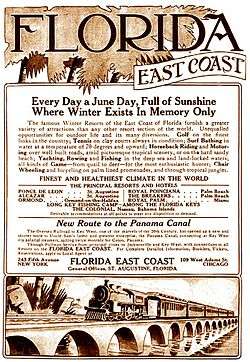
FEC Construction
The railroad south of West Palm Beach was constructed in phases by the FEC and the predecessor systems. Flagler began his railroad building in 1892. Under Florida's generous land-grant laws passed in 1893, 8,000 acres (3,200 ha) could be claimed from the state for every mile (1.6 km) built. Flagler would eventually claim in excess of two million acres (8,000 km²) for building the FEC, and land development and trading would become one of his most profitable endeavors.
Before it became the FEC, the Jacksonville, St. Augustine & Indian River was constructing a line southwards from Daytona Beach in 1894. Fort Pierce was reached on January 29, and West Palm Beach on March 22. Further extension southwards did not begin until June 1895, when a favorable deal was signed with Miami-area business interests. Fort Lauderdale was reached on March 3 of the following year. By April, the construction reached Biscayne Bay, the largest and most accessible harbor on Florida's east coast. Flagler announced in 1904 that the FEC would be extended 128 miles (206 km) to Key West over the ocean. However, in 1906, a powerful hurricane killed 135 of Flagler's workers.[4] The Over-the-Sea Extension was completed in 1912, a mere 16 months prior to Flagler's death, at a cost of $50 million and the lives of hundreds of workmen.
Key West extension
.jpg)
Flagler next sought perhaps his greatest challenge: the extension of the Florida East Coast Railway to Key West, a city of almost 20,000 inhabitants located 128 miles (206 km) beyond the end of the Florida peninsula. He became particularly interested in linking Key West to the mainland after the construction of the Panama Canal was announced by the United States in 1905. As the closest deep-water port in the United States to the canal, Key West was positioned to take advantage of significant new trade with the west that would be enabled by the opening of the canal – this, in addition to the city's existing involvement with Cuban and Latin American trade.
The construction of the Overseas Railroad required many engineering innovations as well as vast amounts of labor and monetary resources. At one time during construction, four thousand men were employed. During the seven years of construction, three hurricanes threatened to halt the project. Workers toiled under conditions sufficiently cruel and harsh that the US Justice Department prosecuted the FECR under a federal slave-kidnapping law.[3] Journalists also chronicled conditions of debt peonage wherein immigrant labor was threatened with prohibitive transportation fees to leave Key West after seeing the unsafe and disease-ridden conditions, essentially forcing them to stay.[5]
Despite the hardships, the final link of the Florida East Coast Railway to Trumbo Point in Key West was completed in 1912. On January 22 of that year, a proud Henry Flagler rode the first passenger train into Key West, marking the completion of the railroad's oversea connection to Key West and the linkage by railway of the entire east coast of Florida.
When the extension was conceived, Key West was a major coaling station for ship traffic between South America and New York. Flagler thought it would be profitable for coal to be brought by railroad to Key West for coaling those ships. By the time the extension was finished in 1912, however, the range of ships had been extended to such a degree that they no longer stopped in Key West for coal.
FEC through the years
The Florida Overseas Railroad, also known as the "Key West Extension of the Florida East Coast Railway", was heavily damaged and partially destroyed in the Labor Day Hurricane of 1935. The Florida East Coast Railway was financially unable to rebuild the destroyed sections, and the line was cut back to Florida City. The roadbed and remaining bridges of the extension were sold to the state of Florida, which built the Overseas Highway to Key West, using much of the remaining railway infrastructure. A rebuilt Overseas Highway (U.S. Route 1), taking an alignment that closely follows the Overseas Railroad's original routing, continues to provide the only highway link to Key West, ending near the southernmost point in the continental United States.[6]
The Florida East Coast Railway benefitted greatly from the Florida land boom of the 1920s, which led to increased traffic. The Moultrie cutoff, which shortened the distance between St. Augustine and Ormond Beach by avoiding the main line's turn towards Palatka, was constructed in 1925; it has since become part of the main line. The main line was also expanded to double track from Jacksonville to Miami in 1926, along with the installation of automatic block signaling.[7][8]
The Stock Market Crash of 1929 and Great Depression were harsh on the FEC. The railroad declared bankruptcy and was in receivership by September 1931, 18 years after Flagler's death. Bus service began to be substituted for trains on the branches in 1932. Streamliners plied the rails between 1939 and 1963, including The East Coast Champion and The Florida Special, which were jointly operated with the Atlantic Coast Line Railroad.
In the early 1960s, Edward Ball, who controlled the Alfred I. duPont Testamentary Trust, bought a majority ownership of FEC, buying its bonds on the open market, allowing the FEC to emerge from bankruptcy following protracted litigation with a group of the company's other bondholders, led by S.A. Lynch and associated with the Atlantic Coast Line which had proposed an alternate plan of reorganization. That same year, a labor contract negotiation turned sour. Ball was determined to save the railroad from the bankruptcy that had continued for more than a decade. Ball was certain that if the company didn't become profitable, the equipment and track would deteriorate to the point where some lines would become unsafe or unusable and require partial abandonment. Later, in 1962, the expanded Cuban embargo added to the woes.
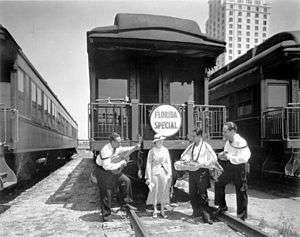
Ball fought ferociously for the company's right to engage in its own contract negotiations with the railroad unions rather than accept an industry-wide settlement that would traditionally contain featherbedding and wasteful work rules. This led to a prolonged work stoppage by non-operating unions beginning January 23, 1963, and whose picket lines were honored by the operating unions (the train crews). From this point forward, the long-distance named passenger trains rerouted over the Seaboard Air Line route through the central interior of the peninsula south of Jacksonville, marking the end of long-distance coastal service between Jacksonville and West Palm Beach. Any resumed service later in the 1960s was strictly intrastate trains operated by the FEC.
Because the strike was by the non-operating unions, a federal judge ordered the railroad to continue observing their work rules, while the railroad was free to change the work rules for the operating unions, who were technically not on strike and thus had no standing in the federal court regarding the strike.
Ball's use of replacement workers to keep the railroad running during the strike led to violence by strikers that included shootings and bombings.[1] Eventually, federal intervention helped quell the violence, and the railroad's right to operate during the strike with replacement workers was affirmed by the United States Supreme Court. As the strike continued, the FEC took numerous steps to improve its physical plant, installed various forms of automation, and drastically cut labor costs. Most of the nation's other railroads did not match these achievements for several years; some still had not as of 2010.[9]
Passenger service became an issue in Florida during the early years of the labor strike, which essentially lasted 14 years, from 1963 to 1977. At the insistence of the City of Miami—which had long fought to get rid of the tracks in the downtown section just north of the county courthouse—Miami's wooden-constructed downtown passenger terminal was demolished by November 1963.[10] Although a new station was planned at NE 36th Street and NE 2nd Avenue,[11] it was never built.
Further, while freight trains were operated with non-union and supervisory crews, passenger runs were not reinstated until August 2, 1965, after the City of Miami sued and the Florida courts ruled that the FEC corporate charter required both coach and first class passenger services to be offered. In response, FEC sold "parlour car seating" for first class accommodations in the rear lounge section of a tavern-lounge-observation car. This new state-mandated passenger service consisted of a single diesel locomotive and two streamlined passenger cars, which, in addition to the operating crew, were staffed by a passenger service agent and a coach attendant, who were "non-operating". The mini-streamliner operated all of the way across three previously observed crew districts (Jacksonville to New Smyrna Beach to Fort Pierce to Miami). Following the letter of the law, the passenger service was bare bones. The trains carried no baggage, remains, mail or express and honoured no inter-line tickets or passes. The only food service was a box lunch (at Cocoa-Rockledge in 1966). On-board beverage service was limited to soft drinks and coffee. Without a station in Miami, the 1950s-era station in North Miami became the southern terminus. This stripped-down service operated six days a week until it was finally discontinued on July 31, 1968.
In 1979, the FEC's mainline was cut back to its current terminus in downtown Miami when a 9.5 mile segment of the mainline between there and Kendall was sold to Miami-Dade Transit, which then built the southern half of Miami's elevated Metrorail system on the former right-of-way.[12] The rest of the former mainline from Kendall south to Homestead and Florida City would remain until 1989, which could still be accessed via the freight bypass through Hialeah (Little River Branch). That segment of the former mainline has since become the South Miami-Dade Busway and the South Dade Rail Trail.
After 23 years under Ball, Raymond Wyckoff took the helm of the company on May 30, 1984.
FEC in modern times
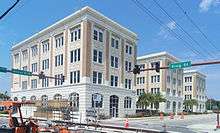
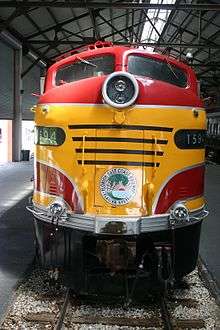
Leadership
In March 2005, Robert Anestis stepped down as CEO of Florida East Coast Industries after a four-year stint, allowing Adolfo Henriquez to assume that position, with John D. McPherson, a long-time railroad man, continuing as president of the railway itself. By this time, the railroad had long since made peace with its workers.
In late 2007, in a move surprising to many employees and railroad industry observers alike, the FEC was purchased for over US$3 billion (including non-rail assets) by Fortress Investment Group, the principal investors who also control short line railroad operator RailAmerica. John Giles was named chairman, and David Rohal was named president. Both men were also principals with major responsibilities at RailAmerica as well, although the ownership of FEC and RailAmerica were not linked corporately, and the spinoff of RailAmerica as a publicly traded company did not include FEC.
In May, 2010, James Hertwig was named as President and Chief Executive Officer of the company effective July 1, 2010. Hertwig had recently retired from CSX, most recently having served as president of CSX Intermodal, one of CSX's major operating units.[13]
James Hertwig retired as President and Chief Executive Officer of the company effective December 31, 2017, and was replaced by Nathan Asplund as the railway was purchased by Grupo México and now manages it along with its other transport interests.
Routing
The Florida East Coast Railway operates from its relocated headquarters in Jacksonville after selling the original General Office Building in St. Augustine to Flagler College in late 2006. Its trains run over nearly the same route developed by Henry Flagler; notably, the Moultrie Cutoff was built in 1925 to shorten the distance south of St. Augustine.
Modern operations
The FEC operations today are dominated by "intermodal" trains and unit rock (limestone) trains. Passenger service was discontinued in 1968 after labor unrest.
The company's major income-earning sources are its rock trains, transporting primarily limestone, and intermodal trains. FEC freight trains operate on precise schedules. Trains are not held for missed connections or late loadings. Most of the trains are paired so that they leave simultaneously from their starting points and meet halfway through the run and swap crews, so they are back home at the end of their runs. The FEC pioneered operation with 2 man crews with no crew districts, which they were able to start doing after the 1963 strike. The entire railroad adopted positive train control (PTC) after a fatal 1987 collision caused by a crew not obeying signaling. (PTC is a safety feature long-sought by federal safety officials for all railroads).
FEC has what is called by some a "prime" railroad right-of-way. The heavy weight of the rock trains required very good trackage and bridges. The railroad has mostly 136 pound-per-yard (66 kg/m) continuous-welded rail attached to concrete ties, which sits on a high quality granite roadbed. The entire railroad is controlled by centralized traffic control with constant radio communication. Because the railroad has only minor grades, it takes very little horsepower to pull very long trains at speed. 60 mph (97 km/h) trains are a normal FEC operating standard.
Passenger service
The FEC was already in the freight only business when Amtrak was created and assumed passenger operations of nearly all U.S. railroads' passenger services in 1971. Periodically, there has been speculation that the southern end of the FEC line might be used for a commuter rail service to complement the existing Tri-Rail line (which follows former CSX tracks to the west). There has also been some discussion about Amtrak or the State of Florida using FEC lines for a more direct route between Jacksonville and Miami.[14]
In March 2012 FEC Industries (not FEC railway) proposed a privately owned and operated service between Miami and Orlando along its route named All Aboard Florida. New high speed trackage would be built between Brevard County (the oceanside county east of Orlando) and Orlando International Airport. In addition to the new track, the main line is once again being expanded to double track from Brevard County to Miami (some of the bridges still have adequate width from the previous double track). In 2014 the very first beginnings of All Aboard Florida commenced with studies and actual construction of the first phase, and construction began in November 2014. In 2015, AAF announced they will operate the service under the name Brightline, since 2018 operated by Virgin Trains USA, after a few delays, service on an initial stretch between West Palm Beach and Fort Lauderdale, and shortly after Miami started in January 2018 with future extensions planned towards Orlando and Tampa.
Rock trains
A lifeblood of the FEC is its transportation of high-grade limestone, which is used in the formulation for concrete and other construction purposes. The limestone is quarried near Miami in the "Lake Belt" area of Dade County and Broward County just west of Hialeah. The rock trains come out of the FEC yard at Medley in Miami-Dade County and the southern end of the FEC service area. Shipments currently are principally for materials dealers Titan and Rinker.
Rinker has since been sold and is now part of the multi-national Cemex. Rock train traffic dropped dramatically in 2008 with the elimination of all but one dedicated rock train. Other rock loads are now added onto other regular trains. Up until mid 2017, only one rock train remained, which is called the "unit train" and operates between Miami and City Point. Since then, rock traffic has rebounded, and the railroad has since added a second unit rock train which handles Ft. Pierce bound rock.
Intermodal services
The intermodal traffic includes interchanged shipments with CSX and Norfolk Southern, participation in EMP container service operated by UP and Norfolk Southern, United Parcel Service (UPS) piggyback trailers, trailers going to the Wal-Mart distribution center at Fort Pierce, and intermodal shipping container traffic through the ports of Miami, Port Everglades (adjacent to Ft. Lauderdale, Florida and the principal source of imports), Port of Palm Beach/Lake Worth Inlet, and Port Canaveral.
Additionally FEC offers "Hurricane Service" offering trucking companies the opportunity of having their trailers piggybacked out of Jacksonville to save the expensive cost of back-hauling empty trailers.
Starting in 2012 the FEC began an aggressive project to reopen direct rail service to the ports of Miami, and Port Everglades. This is in anticipation of the expansion of the Panama Canal and the expected increase of intermodal traffic. In 2013 the drawbridge at the Port of Miami was repaired and reactivated and trains began to roll. In 2014 a new container shuttle was put into operation between Hialeah Yard and the Port of Miami. Also in 2014, the new rail lines into Port Everglades were opened allowing direct access for FEC trains into the port. Further a new transfer facility in Hialeah Yard will add additional intermodal transfer between trains, trucks, and planes. This facility will open by 2015. Additional capacity improvements are planned at other ports as well as the FEC's mainline.
Manifest, other freight
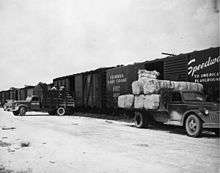
The FEC also hauls normal "manifest" freight to and from points along its right of way. These cars are hauled on whatever train is going that way, so intermodal and rock trains routinely have some manifest cars in their consists.
Additionally, the FEC currently transports Tropicana Products "Juice Train" cars to and from one of the company's processing facilities located on the "K" Line. The Juice Train concept was developed by Tropicana founder Anthony T. Rossi in conjunction with Seaboard Coast Line Railroad (a CSX predecessor) beginning in 1970.
Motive power
The FEC completed its "second generation" dieselization with the purchase of 49 GP40s and GP40-2s and 11 GP38-2s, ranging in the 400's. Most of these locomotives have been extensively rebuilt with others being retired. In 2002, the FEC acquired 20 ex-UP SD40-2s, which were numbered in 700s. These ex UP locomotives remained in their original colors with FEC markings, however as of 2014 seven of them have been repainted into the "retro" Champion scheme. As of 2015 the majority of these were leased to CSXT. In 2006 The FEC leased four SD70M-2's numbered in the 100 series (100-103) in a blue and yellow livery known by fans as the "Classic" or the "Alaskan" schemes. In 2009 when RailAmerica came into the picture, they added four more SD70M-2's (104-107) in the Red, Pearl & Blue scheme which was the standard RailAmerica scheme. That brought the total SD70M-2 count to eight. Seeking further power improvements, in 2009, the FEC leased three CITX SD70M-2's making the count now of 11 of the big EMD's. These locomotives were numbered 140, 141 and 142, all are big blue and white striped units. All of the SD70M-2's served on the railway until the end of 2014 when they were replaced with new power. The fleet GP38-2s are used principally for yard and road switching as well as the occasional local. The others are used as available in road service. Some test runs have been made to observe the effect on fuel consumption of dynamic braking and combinations of new and old power. In 2014 the railway purchased 24 GE ES44C4s, the first General Electric and AC Powered locomotives to be owned by the FEC. All of the GE's have been delivered by the end of 2014 with the first run on November 21, 2014. In 2015 the railway will begin to experiment with LNG fuel that will help with costs and efficiency. With the arrival of the GE's the majority of the FEC's SD40-2's and a number of the SD70M-2's have been temporarily leased to CSXT. As of year end 2017, all SD70M-2's have been returned to their respective leasing companies. Most of the SD40-2's will remain on the FEC with the exception of leases to other companies.
- LNG fuel
FEC is the only US railroad actively using Liquefied Natural Gas to power its 24 dual fuel GE ES44C4 locomotives.[15], a much cleaner fuel than diesel. The locomotives are used in pairs with an LNG fuel tender between them.[16]

Statistics
In 2005 FEC owned and operated:[17]
- 351 miles (565 km) of mainline track between Jacksonville and Miami, Florida
- 277 miles (446 km) of branch, switching, and other secondary track
- 158 miles (254 km) of yard track
Flagler Development owned and operated:
- 64 buildings
- 7.4 million rentable square feet
In 1925 FEC carried 979 million ton-miles of revenue freight and 261 million passenger miles on (at year-end) 849 miles of road and 1411 miles of track; corresponding numbers for 1970 were 1345, 0, 554 and 1058.
Motive Fleet
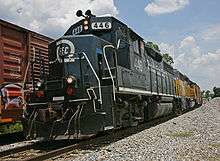
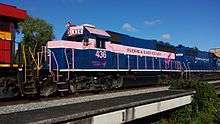
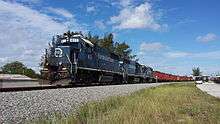
| Road numbers | Model | Notes |
|---|---|---|
| 100–107, 140–142 | EMD SD70M-2 | Numbers 104–107 are painted in RailAmerica's red, pearl and blue colors; Numbers 100–103 were sold off to the Vermont Railway and Providence and Worcester. Numbers 140–142 are painted in CITX blue with white stripes. 100–107 are leased from EMD and scheduled to be returned by the end of 2014. 140–142 are leased from CITX and scheduled to be returned by the end of 2014. CSXT leased FEC 104–107 in 2015 but they are now in storage at the FEC New Smyrna Beach Yard. CSXT also leased CITX 140, 141, and 142 but have been returned to the leaser. |
| 401–410 | EMD GP40 | 402 wrecked parts traded in for #424; reportedly #406 painted yellow, red & black and numbered 2000, 406 / 2000 along with the 403 left the property in 2013. FEC 2000 and 403 were the last pure GP40's left on the railway. All other GP40's have been scrapped or sent off to various Rail America roads. |
| 411–414, 16–18, 20–22, 24–27, 29–38, 40 and 443 | EMD GP40-2 | 423 reblt to #437; 426 on cover of country musician Randy Dukes, album Riding the Rails. 416 repainted into the 1960s "retro blue" in 2013 and a number of others have followed. FEC 434 was the very last GP40-2 ever built by EMD and is still in service on the railway. 412 and 414 have been repainted into a new livery applied by new owner Grupo México. |
| 415, 419, 428, 439, 441 | EMD GP40-3 | |
| 444–449 | EMD GP40-3 | Rebuilt GP40s; dynamic brake equipped. Off the property. |
| 501–511 | EMD GP38-2 | 502 acquired by Chesapeake & Albemarle Railroad. 503 and 504 acquired by North Carolina & Virginia Railroad. 501 and 507 have been repainted into "retro blue". 505 and 506 to the South Carolina Central RR. 509 acquired by Missouri and Northern Arkansas Railroad. |
| 701–720 | EMD SD40-2 | Ex-Union Pacific; Nos 703, 711, 713, 714, 715, 716 & 720 were overhauled & repainted into a yellow, red, and black scheme. These units are liked by many on the FEC and painted in what is referred to as the "Champion" scheme that was used on the FEC E-units that were swapped out at Jacksonville with ACL's units on the New York - Miami passenger train of that name, (and it is a favorite of FEC's President).[18] Unit 701 was completely destroyed( bent frame claimed its life ) after southbound FEC Train 107 had derailed due to a double kink in the rails on May, 9, 2009. 104 was also in the wreck and 35 cars went off the track. All SD40-2 units except for 711 and 715 are being were being used by CSX as leasers in 2015–2016 and have returned to FEC. |
| 2000 | EMD GP40 | unit 406 was a commemorative unit painted in "champion-esque" yellow, red and black. This unit left the property in 2013. |
| Progress Rail 3576 & 3578 | EMD SD40-2 | |
| Progress Rail 9917 | EMD SD40-2 | |
| General Electric 24 units, numbered 800–823 | GE ES44C4[19] | Delivered in November–December 2014; painted in the "champion" scheme. |
Awards and recognition
On May 16, 2006, FEC was the recipient of the Gold E. H. Harriman Award for safety in Group C (line-haul railroad companies with fewer than 4 million employee hours per year).[20]
Corporate history
The Jacksonville, St. Augustine and Indian River Railway Company was incorporated under the general incorporation laws of Florida to own and operate a railroad from Jacksonville in Duval county, through the counties of Duval, St. Johns, Putnam, Volusia, Brevard, Orange, Osceola, Dade, Polk and Hillsborough.
Florida state law chapter 4260, approved May 31, 1893, granted land to the railroad. At that time, it was already in operation from Jacksonville to Rockledge, the part south of Daytona having been constructed by them. The company had just filed a certificate changing and extending its lines on and across the Florida Keys to Key West in Monroe County.
The name was changed to the Florida East Coast Railway Company on September 7, 1895.
Florida East Coast Industries (FECI) incorporated in 1983[17] and was made the holding company for the Railway and the Commercial Realty/Flagler Development Company in 1984. The other subsidiaries are Orlando-based carrier, "EPIK Communication" and the logistics firm, "International Transit".[21]
FECI began operating independently of the St. Joe Company on October 9, 2000[17] when St. Joe shareholders were given FECI stock.
On May 8, 2007, Florida East Coast Railway Company's parent, Florida East Coast Industries (FECI), announced that FECI would be purchased with private equity funds managed by Fortress Investment Group in a transaction valued at $3.5 billion.[22][23] Fortress Investment acquired Florida East Coast Railway from Florida East Coast Industries in March 2008.[23]
On July 7, 2017, Grupo México Transportes, subsidiary of Grupo México, completed the acquisition of Florida East Railway.[24][25]
Lines
Main line
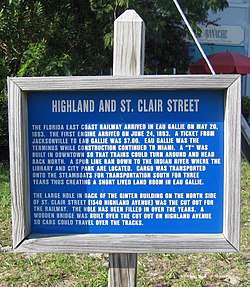
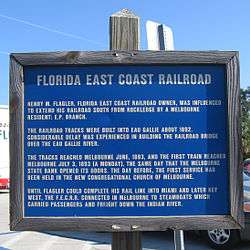
At its greatest extent, Florida East Coast Railway's Main Line ran from Jacksonville via Miami to Key West, a distance of over 500 miles.[26] Today, the Main Line continues to run from Jacksonville to Miami.
Originally, the main line deviated from its current route to serve East Palatka on the St. Johns River. The line ran from St. Augustine southwest to East Palatka, then turned southeast to Bunnell. In 1925, the Moultrie Cutoff was built from St. Augustine directly south to Bunnell to bypass East Palatka.[7] Track to East Palatka remained in service but was downgraded to branch status and is now largely abandoned. The milepost numbers on the main line still reflect the original route, causing the mileposts to abruptly jump from 65 to 88 in Bunnell.[27]
The main line was double-tracked between Jacksonville and Miami in 1926 in response to the Florida land boom of the 1920s. Automatic Block Signals were also installed at the same time. The main line would be restored to single track in the 1970s due to changing rail operations and the absence of passenger operations, though double track is currently being reinstalled south of Cocoa to accommodate Virgin Trains USA.[7][8]
The Key West Extension was removed in 1935 with Florida City subsequently becoming the new southern terminus. The Overseas Highway (US 1) largely runs along the former Key West Extension right of way today.[28] In 1979, the main line was removed between Miami and Kendall. Track from Kendall to Florida City remained and became part of the Little River Branch, but was then abandoned in 1989. Miami-Dade County’s elevated Metrorail, the South Dade Transitway, and the South Dade Rail Trail now run on the former right of way between Miami and Florida City.[12]
- Historic station listing
| Milepost | City | Station[26][29] | Connections and notes |
|---|---|---|---|
| 0.0 | Jacksonville | Jacksonville | rebuilt in 1919 as Jacksonville Union Terminal junction with:
|
| 1.3 | South Jacksonville | ||
| 5.0 | Bowden Yard | ||
| 9.3 | Nesbit | ||
| 12.8 | Greenland | ||
| 15.2 | Bayard | ||
| 20.6 | Durbin | ||
| 24.2 | Woodland | ||
| 27.3 | Sampson | ||
| 31.4 | Magnolia Grove | ||
| 36.7 | St. Augustine | St. Augustine | |
| 37.0 | Moultrie Junction | north junction with Moultrie Cutoff | |
| 40.0 | Tocoi Junction | junction with Tocoi Branch | |
| 44.2 | Hurds | ||
| 47.1 | Elkton | ||
| 49.0 | Armstrong | ||
| 53.7 | Hastings | ||
| 57.4 | Orange Mills | ||
| 61.5 | East Palatka | ||
| Palatka | Palatka | located on a spur across the St. Johns River junction with: | |
| 62.8 | San Mateo Junction | junction with San Mateo Branch | |
| 66.6 | Yelvington | ||
| 68.8 | Roy | ||
| 76.4 | Dinner Island | ||
| 80.3 | Neoga | ||
| 82.3 | Espanola | ||
| 86.6 | Bunnell | Bunnell | south junction with Moultrie Cutoff |
| 90.1 | Dupont | ||
| 97.6 | Harwood | ||
| 99.0 | Volusia | ||
| 101.4 | Tomoka | ||
| 104.2 | Ormond | Ormond | |
| 107.0 | Holly Hill | Holly Hill | |
| 109.8 | Daytona Beach | Daytona | |
| 112.5 | Blake | ||
| 114.7 | Port Orange | Port Orange | |
| 119.3 | Spruce Creek | ||
| 121.3 | Turnbull Bay | ||
| 124.6 | New Smyrna Beach | New Smyrna | junction with Atlantic and Western Branch |
| 127.1 | Edgewater | Hawkes Park | later renamed Edgewater junction with Kissimmee Valley Line |
| 131.0 | Hucomer | ||
| 136.4 | Oak Hill | Oak Hill | |
| 143.2 | Lyrata | ||
| 143.5 | Scottsmoor | ||
| 150.4 | East Mims | ||
| 154.4 | Titusville | Titusville | junction with Enterprise Branch |
| 157.7 | Pritchards | ||
| 162.6 | Delespine | ||
| 165.4 | Frontenac | ||
| 167.7 | Sharpes | ||
| 169.3 | City Point | ||
| 173.1 | Cocoa | Cocoa | later replaced by Cocoa-Rockledge station |
| 174.4 | Rockledge | Rockledge | |
| Rockledge Hotels | located on a spur across Indian River | ||
| 179.4 | Bonaventure | ||
| 182.7 | Pineda | ||
| 189.8 | Melbourne | Eau Gallie | |
| 190.7 | Sarno | ||
| 194.2 | Melbourne | ||
| 197.4 | Palm Bay | Tillman | later renamed Palm Bay |
| 199.9 | Malabar | Malabar | |
| 203.3 | Grant-Valkaria | Valkaria | |
| 205.5 | Grant | ||
| 208.6 | Micco | ||
| 212.4 | Roseland | ||
| 214.5 | Sebastian | Sebastian | junction with Fellsmere Branch |
| 219.3 | Wabasso | ||
| 221.9 | Quay | ||
| 225.5 | Gifford | ||
| 227.8 | Vero Beach | Vero | |
| 231.1 | Oslo | ||
| 234.6 | Viking | ||
| 238.9 | St. Lucie VIllage | St. Lucie | |
| 241.5 | Fort Pierce | Fort Pierce | junction with Lake Harbor Branch |
| 246.4 | White City | ||
| 247.2 | Eldred | ||
| 249.0 | Ankona | ||
| 252.4 | Walton | ||
| 254.4 | Eden | ||
| 256.7 | Jensen | ||
| 258.8 | Rio | ||
| 260.5 | Gosling | ||
| 261.2 | Stuart | Stuart | |
| 266.0 | Salerno | ||
| 266.3 | Aberdeen | ||
| 268.7 | Fruita | ||
| 272.2 | Gomez | ||
| 274.7 | Hobe Sound | moved to a grove on Bridge Road west of Hobe Sound and still extant (Land purchased and developed into the Hobe Sound Polo Club and the old station now serves as the grounds office) | |
| 277.8 | Likely | ||
| 283.3 | Jupiter | Jupiter | later moved to 479 Seabrook Road, Tequesta to be used as a house. Now facing demolition.[30] |
| 290.5 | Palm Beach Gardens | Monet | renamed Palm Beach Gardens |
| 293.3 | Lake Park | Kelsey City | renamed Lake Park |
| 295.3 | Riviera Beach | Riviera | |
| 299.0 | West Palm Beach | West Palm Beach | junction with Palm Beach Branch rebuilt in 2018 a short distance south of original for Virgin Trains USA |
| 300.0 | Palm Beach | Royal Poinciana | located on Palm Beach Branch |
| 300.1 | Breakers | ||
| 306.1 | Lake Worth | Lake Worth | |
| 308.3 | Lantana | Lantana | |
| 309.4 | Hypoluxo | Hypoluxo | |
| 312.3 | Boynton Beach | Boynton | |
| 316.9 | Delray Beach | Delray | |
| 321.3 | Yamato | ||
| 324.6 | Boca Raton | Boca Raton | restored and functioning as a museum |
| 327.0 | Deerfield Beach | Deerfield | |
| 331.1 | Pompano Beach | Pompano | |
| 338.3 | Colohatchee | ||
| 341.2 | Fort Lauderdale | Fort Lauderdale | rebuilt in 2018 a short distant north of original station for Virgin Trains USA |
| 343.3 | Port Everglades Junction | ||
| 345.9 | Dania | Dania | |
| 350.6 | Hallandale Beach | Hallandale | |
| 353.4 | Ojus | ||
| 354.7 | North Miami Beach | Fulford | |
| 357.4 | Arch Creek | ||
| 359.0 | Biscayne | ||
| 360.6 | Miami | Little River | north junction with Little River Branch |
| 361.8 | Lemon City | known today as Little Haiti | |
| 363.2 | Buena Vista | ||
| 365.4 | Miami | rebuilt in 2018 as Virgin MiamiCentral | |
| 370.9 | Coconut Grove | ||
| 373.7 | Larkin | ||
| 376.4 | Kendall | south junction with Little River Branch | |
| 378.6 | Benson | ||
| 379.0 | Keys | ||
| 380.2 | Rockdale | ||
| 381.6 | Perrine | ||
| 382.5 | Peters | ||
| 385.8 | Goulds | ||
| 386.7 | Black Point | ||
| 387.8 | Princeton | ||
| 389.3 | Naranja | ||
| 391.5 | Modello | ||
| 393.9 | Homestead | Homestead | |
| 395.6 | Florida City | Florida City | |
| Key West Extension | |||
| 408.3 | Everglade | ||
| 415.4 | Jewfish | ||
| 417.1 | Key Largo | ||
| 424.3 | Rock Harbor | ||
| 430.8 | Tavernier | ||
| 434.5 | Islamorada | Plantation | |
| 438.2 | Quarry | now the location of Theater of the Sea | |
| 439.9 | Islamorada | ||
| 445.3 | Indian Key | ||
| 447.6 | Midway | ||
| 455.0 | Crescent | ||
| 457.2 | Long Key | ||
| 460.1 | Tom’s Harbor | ||
| 463.9 | Marathon | Grassy | |
| 470.8 | Vaca | ||
| 474.2 | Marathon | ||
| 476.8 | Knights Key Dock | ||
| 485.2 | Bahia Honda | ||
| 495.5 | Ramrod Key | ||
| 503.0 | Sugarloaf | ||
| 518.2 | Stock Island | ||
| 522.0 | Key West | Key West | located on Trumbo Point |
Kissimmee Valley Line
The Kissimmee Valley Line, also known as the Okeechobee Branch, ran from just south of New Smyrna Beach through the Kissimmee Valley roughly paralleling the main line. Branching off the Main Line at Edgewater, it headed southwest to Maytown, where it crossed the Enterprise Branch. From Maytown, it turned south and headed through largely rural agricultural land to Okeechobee, a small town on the north side of Lake Okeechobee. South of Holopaw, the line roughly parallels US 441.[31]
Construction began at Maytown on February 25, 1911 and was completed to Okeechobee in 1915.[32] The line was extended north from Maytown to Edgewater (just south of New Smyrna Beach) in 1916 to have its own connection to the Main Line.[33][34]
By 1929, the branch was extended from Okeechobee southeast and around the eastern side of Lake Okeechobee. It passed through Belle Glade and South Bay before terminating at Lake Harbor on the south side of the lake at the Miami Canal. Here, it connected with the Atlantic Coast Line Railroad's branch from Harrisburg.[34] The Florida East Coast Railway considered extending the line further south to Hialeah to have an alternative route for the main line, but the line was never built past Lake Harbor.[32]
In 1947, the Kissimmee Valley Branch was abandoned from Maytown to Marcy since it ended up not generating the agricultural traffic it had hoped too.[34] At the same time, the remaining line south of Marcy to Lake Harbor was connected to the Main Line at Fort Pierce via new track known as the Glades Cutoff. This segment is still in service as the Lake Harbor Branch.[32]
- Station Listing
| Milepost[35] | City | Station[31] | Connections and notes |
|---|---|---|---|
| 0.0 | Edgewater | Edgewater Junction | junction with Main Line |
| 9.5 | Creighton | ||
| 17.6 | Maytown | junction with Enterprise Branch | |
| 24.0 | Osceola | ||
| 28.8 | Geneva | ||
| 35.9 | Chuluota | ||
| 39.4 | Bithlo | ||
| 47.1 | Pocataw | ||
| 51.5 | Wewahotee | ||
| Narcoossee [36] | |||
| 59.1 | Salofka | ||
| 64.9 | Tohopkee | Mail service terminated 1927 | |
| 71.2 | Holopaw | ||
| 79.8 | Illahaw | Mail service terminated 1935 | |
| 84.7 | Nittaw | Mail service terminated 1935 | |
| 90.0 | Kenansville[37] | named for Henry Flagler's third wife, Mary Lily Kenan | |
| 96.1 | Apoxsee | ||
| 99.1 | Lokosee | ||
| 106.1 | Yeehaw | currently known as Yeehaw Junction | |
| 112.6 | Osawaw[38] | ||
| 118.9 | Fort Drum[39] | ||
| 122.9 | Hilo | currently known as Hilolo | |
| 127.7 | Efal | ||
| 131.8 | Opal | ||
| 139.1 | Okeechobee | Okeechobee | junction with Seaboard Air Line Railroad Miami Subdivision |
| For stations south of Okeechobee, see Lake Harbor Branch | |||
Little River Branch (Bypass around Miami)
The Little River Branch connects to the mainline near Little River and heads south west toward Hialeah, where it turns south towards Hialeah Yard and Miami International Airport. The line sees significant freight traffic since Hialeah Yard is FEC's main yard for the Miami area. The branch ends just south of the airport at Oleander Junction, where it connects with CSX's Homestead Subdivision and the South Florida Rail Corridor.[40] An industrial spur also runs northwest from the line near Medley.
The Little River Branch was historically a freight bypass around downtown Miami when the FEC mainline continued south to Homestead and Florida City. The branch continued south past the airport and reconnected with the mainline at Kendall. Part of the abandoned segment south of the airport is currently planned to become the Ludlam Trail linear park.[41] The line was also realigned in the 1980s to accommodate the extension of Runway 9/27 at Miami International Airport.
- Station Listing
| Milepost | City | Station[42] | Connections and notes |
|---|---|---|---|
| LR 0.0 | Miami | Little River | junction with Main Line |
| LR 4.6 | Hialeah | Iris | junction with Seaboard Air Line Railroad Miami Subdivision (SFRC/CSX) |
| LR 8.5 | Hialeah Yard | ||
| LR 11.8 | Oleander | junction with Seaboard Air Line Railroad Homestead Subdivision (CSX) | |
| LR 14.7 | Tropical Park | ||
| LR 18.0 | Kendall | junction with Main Line | |
Palm Beach Branch
The former Palm Beach branch once extended from the mainline in West Palm Beach east a short distance over Lake Worth Lagoon onto Palm Beach Island. Henry Flagler built the spur to deliver passengers to his two hotels on the island: the Royal Poinciana and The Breakers. The branch’s wooden trestle over Lake Worth Lagoon also included a pedestrian walkway.[43]
The spur was removed in 1902 at the insistence of Flagler’s wife, Mary, who complained about the noise and smoke coming from trains affecting them at their nearby mansion Whitehall. The trestle became a toll bridge, which was replaced by the Flagler Memorial Bridge in 1938 (which carried State Road A1A until 2017 when a new bridge replaced the 1938 span).[44] Much of the former right of way of this branch is still owned by the Town of Palm Beach. [45]
Fellsmere Branch
The former Fellsmere Branch ran from the main line at Sebastian west to Fellsmere. It began operating in 1909 and was run by the Fellsmere Farms Company. In 1924, the line became known as the Trans-Florida Central Railroad.[46]
Lake Harbor Branch
The Lake Harbor Branch (K Branch) runs from Fort Pierce in St. Lucie County to Lake Harbor in Palm Beach County. It basically serves the sugar farms in Palm Beach and Hendry Counties. It branches off the main line in Fort Pierce and heads southwest to Marcy, where it turns south along Lake Okeechobee. At Lake Harbor, it connects to the South Cental Florida Express's main line (a former CSX branch). South Central Florida Express began leasing the line from FEC in 1998 and now fully operates the line from milepost K 15 south. FEC serves local customers on the line from milepost K 15 north, with South Central Florida Express having trackage rights from there into Fort Pierce Yard on the main line.[47] They also have a car haulage arrangement with FEC to Jacksonville to interchange with CSX and Norfolk Southern.
The Lake Harbor Branch was once the southernmost segment of the Kissimmee Valley Line until 1947, when the Glades Cutoff from Marcy to Fort Pierce was built and the rest of the Kissimmee Valley Line was abandoned.
- Station Listing
| Milepost | City | Station[42] | Connections and notes |
|---|---|---|---|
| K 0.0 | Fort Pierce | Fort Pierce | junction with Main Line |
| K 14.0 | Cana | ||
| K 28.5 | Marcy | junction with:
| |
| K 14.0 | Mantola | ||
| K 38.2 | Bessemer | ||
| K 40.0 | Port Mayaca | ||
| K 45.1 | Sand Cut | ||
| K 49.7 | Canal Point | ||
| K 52.5 | Pelican Lake | ||
| K 55.6 | Cardwell | ||
| K 57.6 | Runyon | ||
| K 61.6 | Belle Glade | Belle Glade-Chosen | |
| K 63.0 | Dahlberg | ||
| K 64.5 | South Bay | South Bay | |
| K 70.9 | Lake Harbor | junction with Atlantic Coast Line Railroad Haines City Branch | |
Enterprise Branch
The former Enterprise Branch (E Branch) was built in 1885 by the Atlantic Coast, St. Johns and Indian River Railroad and leased to the Jacksonville, Tampa and Key West Railroad, part of the Plant System. Initially, the westernmost five miles (8 km) served as a connection from Enterprise Junction to Enterprise, a port for steamboat traffic down the St. Johns River. Later, the line was built through Osteen, Kalamazoo, and Mims to Titusville. The Enterprise Branch also crossed the Kissimmee Valley Branch at a location known as Maytown.
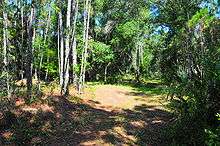
A steam locomotive pulled the first train over the line onto the wharf on the Indian River at Titusville on the afternoon of December 30, 1885, and greatly accelerated the transportation of passengers, produce, seafood, and supplies to and from central Florida. While Titusville thrived thanks to this new transportation connection, Enterprise lost stature as a steamboat port, since Henry Plant's railroad paralleled the St. Johns River and greatly reduced travel times to Jacksonville.
During the winter of 1894–95, a widespread freeze hit twice, decimating the citrus crop and ruining that part of Florida's economy. This allowed Henry Flagler to acquire the line at a discount to piece together what became the Florida East Coast Railway.
The track of the E Branch at one time had been uprooted as far as Aurantia, about five miles (8 km) northwest of Mims, ending directly under the Interstate 95 overpass and has been abandoned. The crossing gates and signals were removed before the summer 2004 hurricanes and the track is being removed by a steel salvage company. As of 2008 the track has been completely removed up to the connection with the current FEC mainline in Titusville.
The Florida Department of Environmental Protection took ownership of the rail bed on December 31, 2007. The corridor will become Florida's longest rails-to-trails project.[48] This rail line would have been suited to recreational railroad use by such groups as the North American Rail Passenger Car Owners' Association assuming a representative who is local to the area could have been located.
- Historic Station Listing
| Milepost | City | Station[42] | Connections and notes |
|---|---|---|---|
| E 0.0 | Titusville | Titusville | junction with Main Line |
| E 2.1 | LaGrange | ||
| E 4.3 | Mims | ||
| E 9.4 | Aurantia | ||
| E 16.5 | Maytown Junction | junction with Kissimmee Valley Line | |
| E 16.8 | Maytown | ||
| E 21.2 | Cow Creek | ||
| E 23.5 | Farmton | ||
| E 29.5 | Osteen | ||
| E 36.3 | Enterprise | ||
| E 40.1 | Benson Junction | junction with Jacksonville, Tampa and Key West Railway (ACL) | |
Atlantic and Western Branch
This former branch, from Blue Spring on the St. Johns River via Orange City to the main line in New Smyrna Beach, was built by the Blue Spring, Orange City and Atlantic Railroad. In the mid-1880s it became the Atlantic and Western Branch of the Jacksonville, St. Augustine and Indian River Railway, which changed its name to the Florida East Coast Railway in 1895. It may have been the Atlantic and Western Railroad in between. The line was in use until 1930.
Tocoi Branch
The railroad from Tocoi to Tocoi Junction, outside St. Augustine, was built by the St. Johns Railway. The Jacksonville, St. Augustine and Indian River Railway took it over by 1894, and changed its name to the Florida East Coast Railway in 1895. The line was abandoned by 1917; it was later used for SR 95, which became SR 214 at some time after the 1945 Florida State Road renumbering, and is now CR 214.
Flagler Beach Branch
The railroad from Flagler Beach to Dorena, north of Bunnell, was built by the Lehigh Portland Cement Company in 1953. The line connected to the Lehigh Portland Cement Company Plant located near Flagler Beach. The line was abandoned in 1963, after a deadly strike erupted in that year that closed the massive plant. The site of the old plant was where some of the monorail beams were assembled for Walt Disney World in the early 1970s. The route is now part of the rails to trails system. The plant has been demolished outside of one smokestack that will become a "lighthouse" for a new development. Some remains of the yard can be found in the woods near the eastern end of the current Lehigh rail trail.
San Mateo Branch
The former San Mateo Branch ran from the main line just southeast of East Palatka south to San Mateo. The branch was built in 1892.[34]
Palatka Branch
The railroad from Palatka to Moultrie Junction, outside St. Augustine, was built by the Jacksonville, St. Augustine and Halifax River Railway. The Jacksonville, St. Augustine and Indian River Railway took it over by 1894, and changed its name to the Florida East Coast Railway in 1895. The line was the main route until the construction of the Moultrie Cutoff in 1925. After the completion of the Moultrie Cutoff, this segment became known as the Palatka Branch (P Branch). There was also a spur with a bridge across the St. Johns River into Palatka, where there was a junction with the Jacksonville, Tampa and Key West Railway and the Florida Southern Railway.[49] The bridge over the river was removed in 1950, and the rest of the line was later abandoned in 1988 and all rail was removed to a point just west of I-95. In 2001, rail service resumed up to this point and track was rehabilitated when new industries were located there. A daily local serves the eastern end of the line today known as the Wilber Wright Industrial Lead. Some of the right-of-way is now the Palatka-to-St. Augustine State Trail.[50]
Mayport Branch
This was originally built by the Jacksonville and Atlantic Railroad, a 3 ft (914 mm) narrow gauge line from Jacksonville to Pablo Beach (now Jacksonville Beach). In late 1899 it was bought by Henry Flagler, who had the line converted to 4 ft 8 1⁄2 in (1,435 mm) standard gauge and extended it north along the coast to Mayport. The new branch opened in March 1900 and was abandoned in October 1932.
Family tree
- Florida East Coast Railway – formed September 13, 1895, as a renaming of the Jacksonville, St. Augustine and Indian River Railroad; still exists
- Jacksonville, St. Augustine and Indian River Railroad – formed October 6, 1892, as a renaming of the FC&G; renamed the Florida East Coast Railway September 13, 1895
- Florida Coast and Gulf Railway – formed May 28, 1892; renamed the Jacksonville, St. Augustine and Indian River Railroad October 6, 1892
- Jacksonville, St. Augustine and Halifax River Railway – formed February 28, 1881, as a renaming of the Jacksonville, St. Augustine and Halifax River Railroad; merged with the Jacksonville, St. Augustine and Indian River Railroad October 31, 1892
- Jacksonville, St. Augustine and Halifax River Railroad – formed March 1879; renamed the Jacksonville, St. Augustine and Halifax River Railway February 28, 1881
- St. Augustine and Palatka Railway – formed September 1, 1885; merged with the Jacksonville, St. Augustine and Indian River Railroad 1893
See also
- Notable passenger trains operated over FEC rails: (sponsoring railroads and destinations)
- Champion-east coast section (Atlantic Coast Line, New York City)
- City of Miami (Illinois Central, Chicago)
- Dixie Flagler (Louisville & Nashville, Chicago & St. Louis)
- Dixie Flyer (Louisville & Nashville, Chicago & St. Louis)
- Ponce de Leon (Southern Railway, Cincinnati)
- Royal Palm (Southern Railway, Cincinnati)
- South Wind (Louisville & Nashville, Chicago)
References
Citations
- "Florida Railroad Strike Is Symbolic of National Test; Company Challenges Established Labor Relations Pattern". The New York Times. February 16, 1964. Retrieved June 27, 2019.
- Keller, Amy (September 1, 2008). "Fla. companies with promise". Florida Trend.
- Bowman, Bryan; Forde, Kathy Roberts (May 17, 2018). "How slave labor built the state of Florida – decades after the Civil War". The Washington Post. Retrieved December 13, 2018.
- "Monthly Weather Review" (PDF). American Meteorological Society. National Oceanic and Atmospheric Administration. 1906. pp. 479–480. Retrieved October 11, 2011.
- Barry, Richard (March 1907). "Slavery in the South Today". The Cosmopolitan. Retrieved December 13, 2018.
- "today".
- Turner, Gregg M. (2005). Florida Railroads in the 1920s. Arcadia Publishing.
- Gardner, Keona. "Straighter tracks preferred for All Aboard Florida trains". TCPalm. Archived from the original on November 13, 2016. Retrieved November 12, 2016.
- Mason, Raymond (February 21, 1999). "A powerful man craved little but gave a lot". Florida Times-Union. Archived from the original on August 12, 2011. Retrieved August 19, 2008.
- Howe, Ward Allan (November 3, 1963). "The Florida Run: Railroads Anticipating a Busy Winter – New Schedule Effective Dec. 13" (PDF). The New York Times. p. XX13. Retrieved March 29, 2011.
- Einstein, Paul (September 23, 1963). "It's Coming Down This Week!". The Miami News. p. 2A. Retrieved March 29, 2011.
- "Miami-Dade Transit History". miamidade.gov. Retrieved July 6, 2016.
- "Hertwig named Florida East Coast Railway CEO". Historiccity.com. May 28, 2010. Retrieved May 15, 2012.
- "Orlando Sun-Sentinel," Feb 22, 2013, Angel Streeter, "Amtrak still hopeful for service on FEC tracks" http://articles.sun-sentinel.com/2013-02-22/news/fl-amtrak-florida-east-coast-railroad-20130215_1_amtrak-service-fec-passenger-service
- Wyman, Oliver. "As Trucks Get More Efficient, Railroads' Competitive Edge Is Eroding". Forbes. Retrieved December 26, 2018.
- http://files.chartindustries.com/FEC-LNG-FloridaEastCoastRailwayCaseStudy.pdf
- "Florida East Coast Industries, LLC: Private Company Information - Businessweek". Businessweek.com.
- "FEC 143". Rrpicturearchives.net. Retrieved May 15, 2012.
- "FEC taps GE Transportation for 24 locomotives". Railway Age. Retrieved January 31, 2014.
- Association of American Railroads (reprinted by Norfolk Southern Railway) (May 16, 2006). "Railroads Set Another Employee Safety Record in 2005". Archived from the original on February 13, 2007. Retrieved May 24, 2006.
- Barton, Susanna (December 5, 2000). "Peyton joins FECI board". Jacksonville Business Journal.
- "Florida East Coast Industries to Be Acquired By Funds Managed By Fortress Investment Group LLC in an All-Cash Transaction Valued at $3.5 Billion" (Press release). Florida East Coast Industries. May 8, 2007. Archived from the original on July 30, 2012. Retrieved May 11, 2007.
- Basch, Mark (July 21, 2008). "FEC rolling along after buyout". Florida Times-Union.
- Lopez, Edwin (June 20, 2017). "Grupo Mexico successfully acquires Florida East Coast Railway". Supply Chain Dive.
- "Grupo México Transportes acquires Florida East Coast Railway" (Press release). Florida East Coast Railway. July 7, 2017. Archived from the original on June 11, 2020. Retrieved June 11, 2020.
- Florida Railroad Commission Annual Report (1913)
- "Geographic Information System". Federal Railroad Administration. U.S. Department of Transportation. Retrieved April 10, 2019.
- Wilkinson, Jerry. "The Bridge That Never Was". Keys Historeum. Retrieved January 9, 2015.
- 'Official Guide of the Railways,' June 1961, Florida East Coast section
- Wagner, Jody, Palm Beach Post, "Tequesta gives groups time to try to save old Flagler train depot"
- FEC Kissimmee Valley Extension Map Kissimmee Valley Line Map
- "More about FEC's "K Branch" Line". TRAVELERS DEN. Retrieved June 1, 2020.
- "The Maytown Branch". GeoCities. Retrieved June 5, 2020.
- Turner, Gregg (2003). A Short History of Florida Railroads. Arcadia Publishing.
- "Florida Railroad: Passenger Stations & Stops" (PDF). Jim Fergusson's Railway and Tramway Station Lists. Retrieved June 5, 2020.
- Narcoossee station
- Kenansville station
- Osawa station
- Fort Drum Depot
- "Rail Convertibility Study" (PDF). Miami-Dade MPO. Retrieved July 6, 2016.
- "Ludlam Trail". Ludlam Trail. Retrieved July 6, 2016.
- Florida East Coast Railway Timetable (1957)
- Cloutier, M.M. (November 15, 2014). "North bridge carries Henry Flagler legacy". Palm Beach Daily News. Retrieved September 30, 2015.
- "The Flagler Memorial Bridge: If this bridge could talk…". Palm Beach Post. October 28, 1995. Retrieved September 30, 2015.
- https://www.pbcgov.com/papa/Asps/PropertyDetail/PropertyDetail.aspx?parcel=74434322130000040&srchtype=map
- Hensley, Donald R. "The Trans-Florida Central RR". Taplines. Retrieved May 29, 2020.
- "Bote's Florida Sugar Cane Train Chaser's Guide". Bote's Railfan Pages. Retrieved March 19, 2019.
- Florida Department of Environmental Protection: January 3, 2008-State Takes Ownership of Longest Rail-Trail in Florida Archived June 8, 2008, at the Wayback Machine
- "FEC - St. Johns River Bridge (Palatka)". Bridgehunter.com. Retrieved December 7, 2016.
- "Palatka-to-St. Augustine State Trail". Trail Link. Retrieved November 14, 2018.
Sources
- Bramson, Seth H. (2002). Speedway to Sunshine: The Story of the Florida East Coast Railway. Boston: Boston Mills Press. ISBN 1-55046-358-6.
- Standiford, Les (2002). Last Train to Paradise. New York: Crown Publishers. ISBN 0-609-60748-0.
- Rand McNally Map – 1917, showing Western Kissimmee Valley Branch
- Biscayne Times: "Waiting for the Train". (Jan. 2009)
External links
- Florida East Coast Railway 1960 timetable
- Florida East Coast Railway Website
- http://www.sethbramsonbooks.com (Includes three books on FEC, many local histories and history of the Plant System)
- Flagler Museum – History of the Florida East Coast Railway
- Florida East Coast Railway Society
- Winchester, Clarence, ed. (1936), "Out to sea by train", Railway Wonders of the World, pp. 109–114 account of the Florida East Coast Railway Key West Extension
- Railroad Bells at A History of Central Florida Podcast
| Preceded by Buffalo and Pittsburgh Railroad |
Regional Railroad of the Year 2007 |
Succeeded by South Kansas and Oklahoma Railroad |